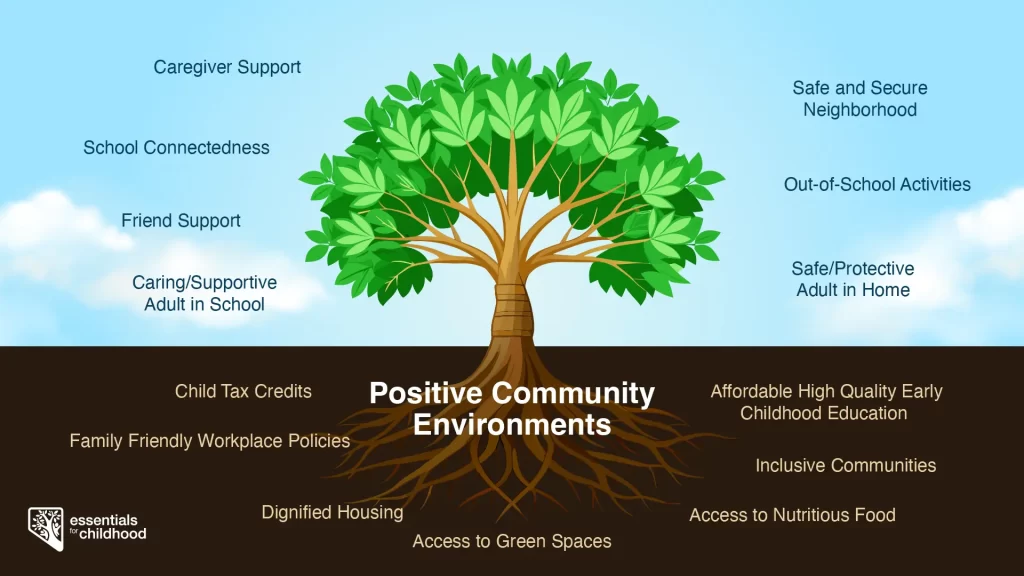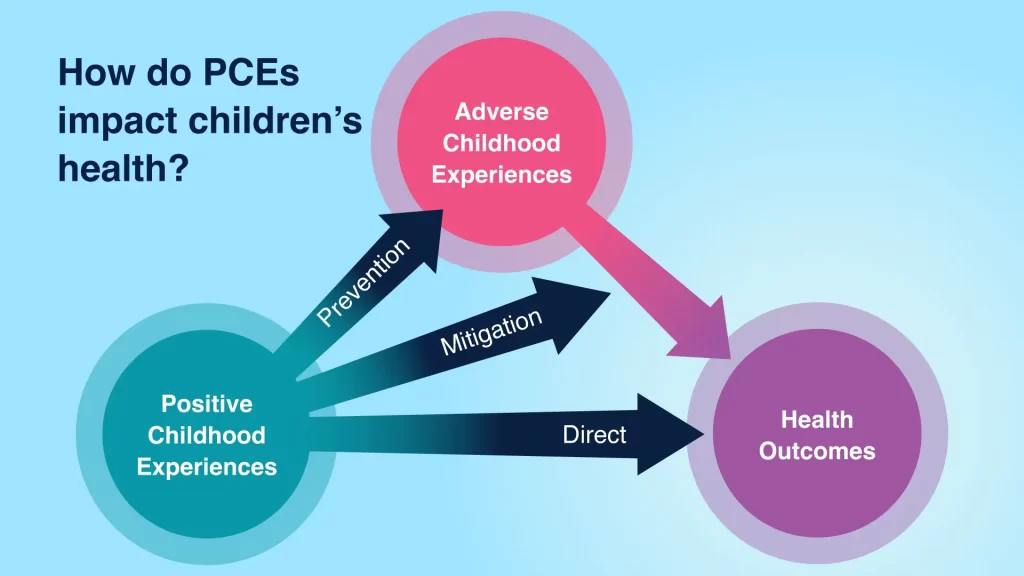About Positive Childhood Experiences
What are positive childhood experiences?
Positive Childhood Experiences, or PCEs, describe a set of interpersonal relationships between family, friends, in school, and in community that fosters a child’s capacity to thrive. PCEs stem from safe, stable, nurturing relationships and can protect children for Adverse Childhood Experiences (ACEs).
Examples include:
- Having a caring and supportive caregiver
- Feeling supported by friends
- Feeling a sense of belonging in school
- Having a caring and supportive adult in school
- Feeling safe and protected by an adult in the home
- Feeling safe and secure in your neighborhood
- Participating in after-school activities.
Several policies and laws can also promote PCEs. Examples include family friendly workplace policies and child tax credits.
How prevalent are positive childhood experiences in Nevada?
In 2023, 47.9% of Nevada’s middle school students reported high family communication and 51.0% reported high school connectedness. [1]. Among Nevada high school students, 47.0% had high family communication and 58.0% had high school connectedness. [2] Subpopulations of youth at greater risk for ACEs, such as those involved with the juvenile justice system also report a wide range of PCEs including school connectedness, family communication, positive peer role models, and non-parental adult role models. [3]
Middle School
Family Communication
High School
Family Communication
Middle School
School Connectedness
High School
School Connectedness
Figure Title: Prevalence of PCEs among Nevada’s secondary students, 2023 YRBS
How do PCEs influence health outcomes?
PCEs can have positive impacts on health and well-being during adolescence and into adulthood. Increases in family communication was associated with 32%-40% lower prevalence of suicidal behaviors among Nevada’s middle schoolers and a 29%-35% lower prevalence among Nevada’s high schoolers. [4] Among Nevada’s juvenile justice population, PCEs were associated with a reduced prevalence of psychological distress [6] and a reduced co-occurrence of psychological distress and substance abuse problems. [3]
PCEs have also been shown to be protective against poor mental health and substance use, even when youth have been exposed to chronic stressors. Even in the presence of high ACE exposure, increases in family communication and school connectedness decreased the prevalence of current marijuana use among Nevada’s middle and high school students [5] and family communication, school connectedness, positive peer role models, and resilience reduced co-occurrence of psychological distress and substance abuse problems in Nevada’s juvenile justice population. [3]
PCEs can also buffer the harmful effects of ACE exposure among youth. Family communication buffered the relationship between ACEs and suicidal behaviors among middle school students in Nevada, and school connectedness buffered the relationship between ACEs and suicide ideation. [4] Among Nevada’s high school student population, family communication modified the relationship ACEs and suicide plans, and school connectedness buffered the relationship between ACEs and suicide ideation. [4] Among Nevada’s juvenile justice population, internal resilience and school connectedness reduced the relationship between ACEs and psychological distress. [6]
Positive experiences during childhood are also associated with better outcomes later in life. Youth with greater exposure to PCEs have better mental health and increased social and emotional support in adulthood. [7]
How can positive childhood experiences be promoted?
Positive childhood experiences can be promoted through multiple strategies.
| Straregy | Approach |
|---|---|
| Strengthen economic supports to families |
|
| Promote social norms that protect against violence and adversity |
|
| Ensure a strong start for children |
|
| Teach skills |
|
| Connect youth to caring adults and activities |
|
| Intervene to lessen immediate and long-term harms |
|
Some examples of initiatives to promote PCEs in Nevada:
- Parenting classes and education. In southern Nevada the PACT coalition has created resources on local parenting classes.
- Expanding family friendly workplace policies. In Nevada, The Children’s Cabinet has partnered with Best Place for Working Parents to bring the businesses of Nevada innovative workplace solutions for the working parents and families in their workforces.
- Public education campaigns. The Nevada EfC team is working on a campaign to encourage help seeking behaviors among parents and guardians.
- Increase access to out-of-school programs. The Nevada Afterschool Network provides outreach and advocacy related to out-of-school program providers.
Learn more about positive childhood experiences:
- Nevada 2023 YRBS MS PCEs report [coming soon]
- Nevada 2023 YRBS HS PCEs report [coming soon]
- HOPE – Healthy Outcomes from Positive Experiences
References
- Cabuhat, M., Powers, M., Howard, L., Zhang, F., Peek, J., Clements-Nolle, K., Yang, W. (2024). University of Nevada, Reno School of Public Health and State of Nevada, Division of Public and Behavioral Health. 2023 Nevada Middle School Youth Risk Behavior Survey (YRBS): Family Communication and School Connectedness Special Report. [Coming Soon]
- Cabuhat, M., Powers, M., Howard, L., Zhang, F., Peek, J., Clements-Nolle, K., Yang, W. (2024). University of Nevada, Reno School of Public Health and State of Nevada, Division of Public and Behavioral Health. 2023 Nevada High School Youth Risk Behavior Survey (YRBS): Family Communication and School Connectedness Special Report.
- Lensch T, Clements-Nolle K, Oman RF, Evans WP, Lu M, Yang W. Adverse childhood experiences and co-occurring psychological distress and substance abuse among juvenile offenders: the role of protective factors. Public Health. 2021 May;194:42-47. doi: 10.1016/j.puhe.2021.02.014. Epub 2021 Apr 12. PMID: 33857872.
- Lensch T, Clements-Nolle K, Oman RF, Evans WP, Lu M, Yang W. Adverse Childhood Experiences and Suicidal Behaviors Among Youth: The Buffering Influence of Family Communication and School Connectedness. J Adolesc Health. 2021 May;68(5):945-952. doi: 10.1016/j.jadohealth.2020.08.024. Epub 2020 Oct 8. PMID: 33039270.
- Clements-Nolle KD, Lensch T, Drake CS, Pearson JL. Adverse childhood experiences and past 30-day cannabis use among middle and high school students: The protective influence of families and schools. Addict Behav. 2022 Jul;130:107280. doi: 10.1016/j.addbeh.2022.107280. Epub 2022 Feb 14. PMID: 35279622; PMCID: PMC9223419.
- Clements-Nolle K, Waddington R. Adverse Childhood Experiences and Psychological Distress in Juvenile Offenders: The Protective Influence of Resilience and Youth Assets. J Adolesc Health. 2019 Jan;64(1):49-55. doi: 10.1016/j.jadohealth.2018.09.025. PMID: 30579436.
- Bethell C, Jones J, Gombojav N, Linkenbach J, Sege R. Positive Childhood Experiences and Adult Mental and Relational Health in a Statewide Sample: Associations Across Adverse Childhood Experiences Levels. JAMA Pediatr.2019;173(11):e193007. doi:10.1001/jamapediatrics.2019.3007



